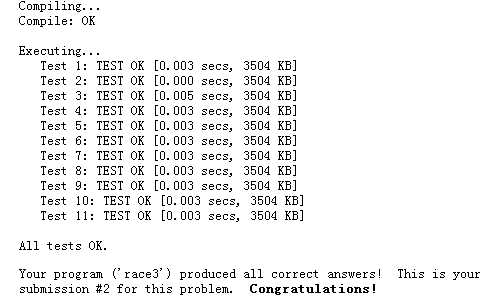标签:

虽说是IOI‘95,但是也是挺水的..for 第一问,n最大为50,所以可以直接枚举起点和终点之外的所有点,然后dfs判断是否连通;for 第二问,易知答案一定是第一问的子集,所以从第一问中的答案中枚举,也是用dfs判断。

#include<cstdio> #include<iostream> #include<cstring> #include<algorithm> #include<vector> #define rep(i,r) for(int i=0;i<r;i++) #define clr(x,c) memset(x,c,sizeof(x)) using namespace std; const int maxn=50+5; int n=0; int vis[maxn]; vector<int> g[maxn]; void read() { for(;;) { int t,pd=0; g[n].clear(); while(scanf("%d",&t) && t!=-2) { if(t==-1) { pd=1; break; } g[n].push_back(t); } if(pd) break; n++; } } int dfs(int i) { vis[i]=1; rep(j,g[i].size()) { int t=g[i][j]; if(t==n-1) return 1; if(vis[t]) continue; if(dfs(t)) return 1; } return 0; } void DFS(int i) { vis[i]=1; rep(j,g[i].size()) { int t=g[i][j]; if(vis[t]) continue; DFS(t); } } int dfsJudge(int i) { vis[i]=2; rep(j,g[i].size()) { int t=g[i][j]; if(vis[t]==1) return 1; if(vis[t]) continue; if(dfsJudge(t)) return 1; } return 0; } void work() { vector<int> ans; ans.clear(); for(int i=1;i<n-1;i++) { clr(vis,0); vis[i]=1; if(!dfs(0)) ans.push_back(i); } cout<<ans.size(); rep(i,ans.size()) cout<<‘ ‘<<ans[i]; cout<<endl; vector<int> ans2; ans2.clear(); rep(i,ans.size()) { clr(vis,0); vis[ans[i]]=2; DFS(0); if(!dfsJudge(ans[i])) ans2.push_back(ans[i]); } printf("%d",ans2.size()); rep(i,ans2.size()) printf(" %d",ans2[i]); cout<<endl; } int main() { freopen("race3.in","r",stdin); freopen("race3.out","w",stdout); read(); work(); return 0; }
Figure 1 gives an example of a course for a street race. You see some points, labeled from 0 to N (here, N=9), and some arrows connecting them. Point 0 is the start of the race; point N is the finish. The arrows represent one-way streets. The participants of the race move from point to point via the streets, in the direction of the arrows only. At each point, a participant may choose any outgoing arrow.

A well-formed course has the following properties:
A participant does not have to visit every point of the course to reach the finish. Some points, however, are unavoidable. In the example, these are points 0, 3, 6, and 9. Given a well-formed course, your program must determine the set of unavoidable points that all participants have to visit, excluding start and finish.
Suppose the race has to be held on two consecutive days. For that purpose the course has to be split into two courses, one for each day. On the first day, the start is at point 0 and the finish at some `splitting point‘. On the second day, the start is at this splitting point and the finish is at point N. Given a well-formed course, your program must also determine the set of splitting points. A point S is a splitting point for the well-formed course C if S differs from the star t and the finish of C, and the course can be split into two well-formed courses that (1) have no common arrows and (2) have S as their only common point, with S appearing as the finish of one and the start of the other. In the example, only point 3 is a splitting point.
The input file contains a well-formed course with at most 50 points and at most 100 arrows. There are N+2 lines in the file. The first N+1 lines contain the endpoints of the arrows that leave from the points 0 through N respectively. Each of these lines ends with the number -2. The last line contains only the number -1.
1 2 -2 3 -2 3 -2 5 4 -2 6 4 -2 6 -2 7 8 -2 9 -2 5 9 -2 -2 -1
Your program should write two lines. The first line should contain the number of unavoidable points in the input course, followed by the labels of these points, in ascending order. The second line should contain the number of splitting points of the input course, followed by the labels of all these points, in ascending order.
2 3 6 1 3
USACO Section 4.3 Street Race(图的连通性+枚举)
标签:
原文地址:http://www.cnblogs.com/JSZX11556/p/4327064.html